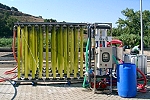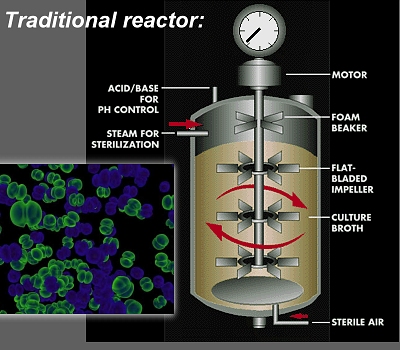|
|
Food for thought |
|
|
Large amounts of fuel ethanol can be produced from city wastes by local micro-breweries.
|
|
|
There are now many kinds of independent small-scale local operations producing and using millions and millions of gallons of biofuels a year, growing fast.

|
|
|
On the basis of calculations, a reactor shaped like a cube measuring three metres per side and filled with algae could supply a two-person household with their energy needs.
|
|
|
While soya typically produces 450 litres of biodiesel pr. hectare pr. year, researchers now predict that a hectare of algae could produce more than 90,000 litres of biodiesel.

|
|
|
Micro algae production as a supplier of feed supplements for livestock and farmed fish has a huge short- and medium term potential, since possible resource shortage of feed components in existing production is an immediate threat to this industry.
|
|
|
Bioreactor design has been referred to as one of the main obstacles for stable, productive commercialisation of many small-scale laboratory experiments involving microorganisms like yeasts, bacteria and algae.
|
|
|
|
CELLATOR - Novel bioreactor with improved process stability and productivity
|
|
|
CELLATORTM is a new invention for bioreactor design, with patents currently pending under a range of jurisdictions internationally. The CELLATOR design achieved a 2. price in a prestiguous award issued by the University of Oslo and Oslo Innovation Centre.
|
|
|
 The scale-up challenge obstructs many biotechnological processes from being successfully transformed from small-scale laboratory conditions to large-scale, high-yield industrial production. The CELLATOR bioreactor design provides a set of novel and unique properties which may bring new chances to particularly difficult processes involving growth of microorganisms like yeast, micro-algae and bacteria. The scale-up challenge obstructs many biotechnological processes from being successfully transformed from small-scale laboratory conditions to large-scale, high-yield industrial production. The CELLATOR bioreactor design provides a set of novel and unique properties which may bring new chances to particularly difficult processes involving growth of microorganisms like yeast, micro-algae and bacteria.
The CELLATOR reactor may also - under a broad range of conditions - make existing growth processes substantially more stable and productive than current reactors.
Computer simulations of the CELLATOR system have been performed, a range of third-party laboratory experiments are available, and financing of small-scale test reactors is the next step. Investors are welcome.
This Web site has restricted access. Password is issued by the inventor, who holds a PhD in Biology from the University of Oslo.
He has broad experience both as researcher, inventor and entrepreneur.
Updated: October 2009.
|
|

